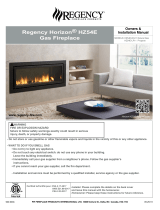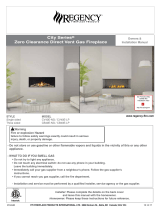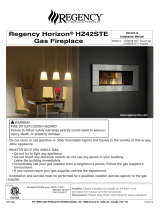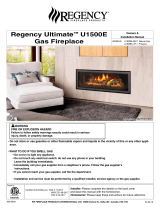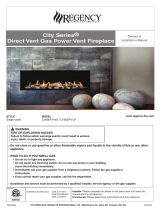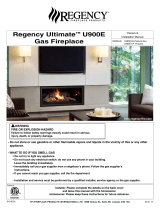Page is loading ...

080211-36 TC54.CE2 5056.42562
This appliance may be installed in an aftermarket
permanently located, manufactured home (USA
only) or mobile home, where not prohibited by
local codes.
This appliance is only for use with the type of gas
indicated on the rating plate. This appliance is
not convertible for use with other gases, unless
a certi ed kit is used.
This appliance is suitable for installation in a
bedroom or bed sitting room
INSTALLATION
AND OPERATING
INSTRUCTIONS
MODEL
TC54.CE2
SERIES C
MODULAR DIRECT VENT
FIREPLACE
INSTALLER:
Leave this manual with the appliance.
CONSUMER:
Retain this manual for future reference.
WARNING: If the information in these
instructions is not followed exactly, a re
or explosion may result causing property
damage, personal injury or death.
FOR YOUR SAFETY
Do not store or use gasoline or other
ammable vapors and liquids in the vicinity
of this or any other appliance.
WHAT TO DO IF YOU SMELL GAS
• Do not try to light any appliance.
• Do not touch any electrical switch;
• Do not use any phone in your building.
• Immediately call your gas supplier from
a neighbour’s phone. Follow the gas
supplier’s instructions.
• If you cannot reach your gas supplier call
the re department.
Installation and service must be performed by
a quali ed installer, service agency or the gas
supplier.

Table of Contents
Caution ........................................................................................... 3
Safety ............................................................................................. 3
Massachusetts Rules and Regulations ........................................... 4
Fireplace Dimensions ..................................................................... 5
Minimum Clearances to Combustible Material ............................... 5
Installation Requirements ............................................................... 6
Manufactured (Mobile) Home .........................................................6
Window Frame Removal .................................................................6
Top Standoffs .................................................................................. 7
Locating The Fireplace ...................................................................7
Framing and Finishing ....................................................................8
Steel Stud Framing Kit .................................................................. 10
Hearth Extension .......................................................................... 12
Maestro Control ........................................................................... 13
– Plumbing and Electrical ............................................................. 13
Gas Supply ................................................................................... 15
Gas Pressure Check ..................................................................... 15
Horizontal Termination Venting .................................................... 16
(Power Vented) ............................................................................. 16
Vertical Termination Venting ......................................................... 16
Roof Termination Venting Chart .................................................... 17
Vent Terminal Clearance ...............................................................20
Vent Restrictor Adjustment ........................................................... 21
Firebox Panels Installation ............................................................22
Finishing Touch Trim Kit Instructions .............................................23
Lighting Instructions .....................................................................24
First Fire ........................................................................................24
Maestro Control System ...............................................................25
Remote Control Initial Setup ......................................................... 25
Maestro Control System - Operation ............................................26
APPENDIX
Maintenance .............................................................................29
Replacement Parts ...................................................................30
Replacement Parts – Maestro Control System ......................... 31
Wiring Diagram .........................................................................32
Roof Termination Kit ............................................................... 33
Vent Pipe Dimensions ..............................................................34
Vent Offset Chart ......................................................................34
Safety Label Location ............................................................... 35
2
TC54.CE2 080211-36

FOR YOUR SAFETY - Do not install or operate your Town & Country replace without
rst reading and understanding this manual. Any installation or operational deviation from
the following instructions voids the Town & Country FireplacesTM Warranty and may prove
hazardous.
This appliance and its individual shut off valve must be disconnected from gas supply piping
system during any pressure testing of that system at test pressures in excess of 1/2 psig
(3.5 kPa).
This appliance must be isolated from the gas supply piping system by closing its individual
manual shut off valve during any pressure testing of the gas supply piping system at test
pressures equal to or less than 1/2 psig (3.5 kPa).
Note: When lit for the rst time, the appliance will emit a slight odour for a couple of hours.
This is due to the curing of paints, sealants and lubricants used in the manufacturing process.
This condition is temporary. Open doors and windows to ventilate area. Smoke and fumes
caused by the curing process may cause discomfort to some individuals.
Do not use the replace if any part has been under water. Immediately call a quali ed service
technician to inspect the replace and to replace any part of the control system and any gas
control which has been under water.
Due to high temperatures, this gas appliance should be located out of traffic and away
from furniture and draperies.
Children and adults should be alerted to the hazards of high surface temperatures
and should stay away to avoid burns or clothing ignition.
Young children should be carefully supervised when they are in the same room as
the appliance.
Clothing or other ammable material should not be placed on or near the appli-
ance.
Any grill, panel or door removed for servicing the unit must be replaced prior to
operating. Failure to do so may create a hazardous condition.
Installation and repair should be done by a quali ed service person. The appliance
should be inspected before use and at least annually by a professional service person.
More frequent cleaning may be required due to excessive lint from carpeting, bedding
material, etc.. It is imperative that control compartments, burners and circulating air
passageways of the appliance be kept clean.
It is our policy that no responsibility is assumed by the Company or by any of its
employees or representatives for any damages caused by an inoperable, inadequate,
or unsafe condition which is the result, either directly or indirectly, of any improper
operation or installation procedures.
This appliance must not be connected to a chimney ue serving a separate solid fuel
burning appliance.
We recommend that our gas hearth
products be installed and serviced
by professionals who are certi ed
in the United States by the National
Fireplace Institute® (NFI) as NFI Gas
Specialists
3
TC54.CE2 080211-36
Caution
Safety

Important Note for the Commonwealth of Massachusetts:
From Massachusetts Rules and Regulations 248 CMR 5.08:
(a) For all side wall horizontally vented gas fuelled equipment installed in every dwelling, building or structure used in whole or in part for residential
purposes, including those owned or operated by the Commonwealth and where the side wall exhaust vent termination is less than seven (7) feet above
nished grade in the area of the venting, including but not limited to decks and porches, the following requirements shall be satis ed.
1. INSTALLATION OF CARBON MONOXIDE DETECTORS. At the time of installation of the side wall horizontal vented gas fuelled equipment, the
installing plumber or gas tter shall observe that a hard wired carbon monoxide detector with an alarm and battery back-up is installed on the oor level
where the gas equipment is to be installed, in addition, the installing plumber or gas tter shall observe that a battery operated or hard-wired carbon
monoxide detector with an alarm is installed on each additional level of the dwelling, building or structure served by the side wall horizontal vented gas
fuelled equipment. It shall be the responsibility of the property owner to secure the services of quali ed licensed professionals for the installation of
hard-wired carbon monoxide detectors.
a. In the event that the side wall horizontally vented gas fuelled equipment is installed in a crawl space or an attic, the hard-wired carbon monoxide
detector with alarm and battery back-up may be installed on the next adjacent oor level.
b. In the event that the requirements of this subdivision cannot be met at the time of completion of installation, the owner shall have a period of thirty
(30) days to comply with the above requirements; provided, however, that during said thirty (30) day period, a battery operated carbon monoxide detec-
tor with an alarm shall be installed.
2. APPROVED CARBON MONOXIDE DETECTORS. Each carbon monoxide detector as required in accordance with the above provisions shall
comply with NFPA 720 and be ANSI/UL 2034 listed as IAS certi ed.
3. SIGNAGE. A metal or plastic identi cation plate shall be permanently mounted to the exterior of the building at a minimum height of eight (8) feet
above grade directly in line with the exhaust vent terminal for the horizontally vented gas fuelled heating appliance or equipment. The sign shall read, in
print size no less than one-half (1/2) inch in size, “GAS VENT DIRECTLY BELOW. KEEP CLEAR OF ALL OBSTRUCTIONS”.
4. INSPECTION. The state or local gas inspector of the side wall horizontally vented gas fuelled equipment shall not approve the installation unless,
upon inspection, the inspector observes carbon monoxide detectors and signage installed in accordance with the provisions of 248 CMR 5.089(2)(a) 1
through 4.
(b) EXEMPTIONS. The following equipment is exempt from 248 CMR 5.089(2)(a) 1 through 4.
1. The equipment listed in Chapter 10 entitled “Equipment Not Required To Be Vented” in the most current edition of NFPA 54 as adopted by the
Board; and
2. Product Approved side wall horizontal vented gas fuelled equipment installed in a room or structure separate from the dwelling, building or struc-
ture used in whole or in part for residential purposes.
(c) MANUFACTURER REQUIREMENTS – GAS EQUIPMENT VENTING SYSTEM PROVIDED. When the manufacturer of Product Approved side
wall horizontally vented gas equipment provides a venting system design or venting system components with the equipment, the instructions provided by
the manufacturer for installation of the equipment and the venting system shall include:
1. Detailed instructions for the installation of the venting system design or the venting system components; and
2. A complete parts list for the venting system design or venting system.
(d) MANUFACTURER REQUIREMENTS – GAS EQUIPMENT VENTING SYSTEM NOT PROVIDED. When the manufacturer of a Product Approved
side wall horizontally vented gas fuelled equipment does not provide the parts for venting the fuel gases, but identi es “special venting systems”, the fol-
lowing requirements shall be satis ed by the manufacturer.
1. The referenced “special venting system” instructions shall be included with the appliance or equipment installation instructions; and
2. The “special venting systems” shall be Product Approved by the Board, and the instructions for that system shall include a parts list and detailed
installation instructions.
(e) A copy of all installation instructions for all Product Approved side wall horizontally vented gas fuelled equipment, all venting instructions, all parts
lists for venting instructions, and/or all venting design instructions shall remain with the appliance or equipment at the completion of the installation.
4
TC54.CE2 080211-36

59 5/16"
35 5/16"
53 9/16"
31 1/4"
* MANTEL CLEARANCE
A 17”
B 15”
C 12”
** MANTEL DEPTH
D 12”
E 6”
F 1”
MANTEL CLEARANCE
CHART
NOTE:
To ensure that the
hearth does not
interfere with the
window frame, the
replace must be
raised.
Refer to
‘Hearth Extension’
section for details.
Minimum Clearances:
Side standoffs ........................................ 0 in. (0 mm)
Back standoffs ....................................... 0 in. (0 mm)
Top standoffs ......................................... 0 in. (0 mm)
Bottom of appliance ............................... 0 in. (0 mm)
Adjacent side wall .................................. 4 in. (102 mm)
Ceiling to appliance ............................. 24 in. (610 mm)
*Mantel to appliance ................... See Fig.#2
**Maximum Mantel extension ..... See Fig.#2
Mantel support ....................................... 4 in. (102 mm)
Vertical vent pipe ...........................1 3/4" in. (45 mm)
Horizontal Vent pipe
(Top, sides and bottom) ..................1 3/4" in. (45 mm)
Fig. #3
24”
4”
MANTEL
ADJACENT WALL
OR MANTEL SUPPORT
CEILING
A 18" DEEP, 2" THICK, NON-COMBUSTIBLE HEARTH MUST
BE PLACED IN FRONT OF THE FULL WIDTH OF THE GLASS
*
**
Fig. #1 16 7/16”
48 1/8”
31 1/4”
15 3/4”
63 7/8”
44 1/8”
53 9/16”
59 5/16"
53 9/16"
35 5/16"
31 1/4"
Fig. #2
MAY USE COMBUSTIBLE
FACING MATERIAL IN THIS AREA
NON-COMBUSTIBLE
FINISH MATERIAL
SEE FIG #8 & #9
NON-COMBUSTIBLE ZONE.
DO NOT INSTALL ANY COMBUSTIBLE MATERI-
AL, ELECTRICAL WIRING OR GAS PLUMBING IN
THIS AREA.
COMBUSTIBLE FRAMING AND
FINISH WALL ABOVE STANDOFFS
STANDOFFS
STEEL FRAMING
FIREPLACE FRONT
TOP OF LINTEL BAR
A
B
C
D
E
F
43 5/8”
5
TC54.CE2 080211-36
Fireplace Dimensions
Minimum Clearances to Combustible Material

LATCH HANDLE
Fig. #4
Fig. #5
Fig. #5a
The Town & Country Fireplace installation and venting must conform to the current
Natural Gas and Propane installation code CAN/CSA-B149.1 (in Canada) or the current
National Fuel Gas Code, NFPA54/ANSI Z223.1 (in the USA), and approved per local
codes. Only quali ed (licensed or trained) personnel should install this product.
In the state of Massachusetts, only a licensed Plumber and Gas Fitter may install
this product.
In some jurisdictions, the Town & Country Fireplace may be installed in Manufactured Homes
after the " rst sale". Consult local codes for approval. The replace must be fastened
in place.
Install in accordance with the current standard Mobile Homes, CAN/CSA Z240 MH (in
CANADA), and the Manufacturer's Home Construction and Safety Standard, Title 24 CFR,
Part 3280 or the current Standard for Fire Safety Criteria for Manufactured Home Installa-
tions, Sites and Communities ANSI/NFPA 501A (in the USA).
Warning: Turn off the replace, and allow ample time for the unit to cool before
proceeding.
Caution: The ceramic glass is very fragile, and should be handled with care.
The window frame is held in place by two spring-loaded latches that are operated by a
one-piece latch handle.
1. Remove the TC Finishing Touch Trim Kit from the window frame. (If installed)
2. Using a screwdriver or other similar object, push against the notch in the top of the
latch and grab the bottom of the latch handle as it protrudes. Lift handle until latch hook
disengages. Repeat for other side while holding glass so it does not tip out.
3. Tilt the top of the window frame out to clear the top edge of the unit. Grasp the sides of
the frame and lift up and out to disengage from its bottom track.
4. Place the window frame in a safe place to avoid damage.
5. Re-assemble in reverse order. Latch handle should snap into place and be ush with
window frame when engaged correctly.
6. Reinstall Trim Kit if required.
TIP:
To ensure glass is properly latched, grasp the top left and
right sides of the glass frame, under moderate pressure it
should pull forward and return to original position evenly on
both sides.
6
TC54.CE2 080211-36
Installation Requirements
Manufactured (Mobile) Home
Window Frame Removal

The top standoffs are shipped loose inside
the replace and must be installed on top
of the replace as shown in Fig #6. Do this
once the replace is on site and in position.
In planning the installation for the replace, it is necessary to determine where the unit is to
be installed, location of vent system and where gas supply piping may be plumbed. Various
installations are possible, such as, into an existing wall, a corner, a built-in wall or a wall
projection (Fig #7). Due to high temperatures, do not locate this replace in areas of high
traffic or near furniture or draperies.
The minimum clearances from the replace to combustible surfaces must be adhered
to and are shown in Fig #2 and Fig #3.
Fig. #6 TOP STANDOFFS
EXAMPLES OF COMMON LOCATIONS
SEE FIG #9 FOR DIMENSIONS
Fig. #7
7
TC54.CE2 080211-36
Locating The Fireplace
Top Standoffs

18 3/4"
44 1/8"
63 1/2"
63 7/8"
63 1/2"
5"
Note: The replace should be in place
and venting installed before framing in or
building an enclosure around the unit.
The Town & Country replace must be
framed in as described below or totally en-
closed with non-combustible material, such
as facing brick.
Determine the total thickness of facing
material to be used. A thickness of 3/4" will
allow the nishing surface to be ush with
the front of the unit. If preferred, additional
masonry type non-combustible material can
be installed above and to the sides up to 6
inches proud of the appliance.
The nishing material must not interfere
with glass frame access or movement.
A Steel Stud Framing Kit is supplied with the
replace and must be used unless the
replace is totally enclosed with
non-combustible material. Assemble the
framing kit as per the instructions on pages 10
& 11 of this manual. Attach the steel frame to
the replace once the replace is in its nal
position. Secure the steel frame to the framing
brackets on each side of the unit. Ensure that
the studs are set back far enough to allow
for thickness of nishing surface.
The sides, back and top of the replace can
be framed in up to the steel studs and the
replace standoffs using conventional
lumber. Consult local building codes for
speci c requirements.
Due to high temperatures, non-combustible
backer board is supplied with the replace
and must be used to sheet in the front of the
replace, extending 18 3/4" above and 5 " to
the side of the framing edge bars. (Fig #9)
Standard sheet rock (dry wall) may be used
beyond this.
If the backer board is not to be nished with
other non-combustible material such as tiles,
it is recommended that top sections of board
supplied with framing kit be replaced with
a single sheet of non-combustible board.
Taped and mudded joints may crack due to
the elevated temperatures.
Chase Insulation: When installing this
replace against a non-insulated exterior wall
or chase, it is recommended that the outer
walls be insulated to same degree as other
exterior walls. Do not place replace directly
against the insulation. Cover the insulation
and plastic vapour barrier with a solid surface,
such as dry wall (sheet rock). Consult local
codes. Do not insulate or use plastic vapour
barrier within the framing kit.
NOTE:
The chase must be properly
sealed at the ceiling level or
between oors in a multilevel
installation.
See "Ceiling Firestop" section.
Fig. #8
NON-COMBUSTIBLE ZONE. DO NOT INSTALL ANY
COMBUSTIBLE MATERIAL, ELECTRICAL WIRING, INSU-
LATION, PLASTIC VAPOR BARRIER OR GAS PLUMBING
WITHIN THE STEEL STUD FRAMING ALL OTHER FRAMING CAN
BE DONE WITH
CONVENTIONAL LUMBER
STEEL STUD FRAMING KIT DIMENSIONS
(Supplied with replace)
8
TC54.CE2 080211-36
Framing and Finishing

5 7/8
18 3/4
101 3/4
71 3/4
72 1/8
35 1/4
24 3/8
w
18 3/4"
5"
NON-COMBUSTIBLE BOARD DETAIL
Fig. #9
Fig. #10
Fig. #11
NON-COMBUSTIBLE BOARD (OR
OTHER NON-COMBUSTIBLE
MATERIAL) MUST EXTEND 18
3/4" ABOVE AND 5" TO THE
SIDES OF THE FRAMING EDGES.
NON-COMBUSTIBLE BOARD
MINIMUM COMBUSTIBLE FRAMING DIMENSIONS
NOTE: FIREPLACE SHOULD BE IN ITS FINAL LOCATION BEFORE FRAMING.
NON-COMBUSTIBLE RECESSED
INSTALLATION DETAIL
STEEL STUDS
NON-COMBUSTIBLE
MATERIAL
NON-COMBUSTIBLE
BOARD
INCLUDING SHEET ROCK
IF THE BACKER BOARD IS NOT TO BE
FINISHED WITH OTHER NON-COMBUS-
TIBLE MATERIAL SUCH AS TILES, IT IS
RECOMMENDED THAT TOP SECTIONS
OF BOARD SUPPLIED WITH FRAMING
KIT BE REPLACED WITH A FULL SHEET
OF NON-COMBUSTIBLE BOARD. TAPED
AND MUDDED JOINTS MAY CRACK DUE
TO THE ELEVATED TEMPERATURES.
FULL SHEET OF A NON-
COMBUSTIBLE MATERIAL
(NOT INCLUDED IN KIT)
Fig. #9A
9
TC54.CE2 080211-36

Each Kit Contains: Item Part # Description Qty.
1 5048.401 SCREW, TEKS Pkg
#8 x 1/2 40
2 8193 STUD, SIDES,
63 3/4”L 2
3 8192 STUD, OUTER
SIDES, 63 3/4”L 2
4 8195 STUD, CENTER,
19 7/16”L 3
5 8194 STUD, HEADER,
63 1/2”L 1
6 8194.2 STUD, PLATE,
57 1/16”L 1
7 8198 NON-COMBUSTIBLE BOARD,
TOP CENTRE 18 3/4” x 28” 1
8 8198.1 NON-COMBUSTIBLE BOARD,
TOP L & R 18 3/4” x 17 3/4” 2
9 8198.5 NON-COMBUSTIBLE BOARD,
SIDE 5” x 44 1/8” 2
10 9194.5 BASE PLATE
5 3/4”L 2
11 5049.993 SCREW, DRYWALL, Pkg
1 1/4” 30
1. Top Frame Assembly
• Lay out side studs (2) and center studs
(4) on a large at surface. (Fig #12)
• Using the screws provided (1), attach the
header stud (5) and the plate stud (6) to
the center studs (4).
TC54.FRKT
Fig. #12
11
1
2
5
10
9
6
3
8
7
4
10
TC54.CE2 080211-36
Steel Stud Framing Kit

NAIL TABS
2. Attach Side Studs (Legs)
• Attach the outer side studs (3) to the top
of the header stud (5). (Fig #13)
• Fasten the outer side studs (3) at the
bottom using the base plates (10).
3. Attach the Assembled Frame to
the Unit
• Align the assembled frame to the unit
framing brackets (Fig #14). Attach at the
fastening points through the access holes
in the outer side studs (3).
4. Secure to Existing Framing
• Secure the frame assembly to existing
framing through the stud header (5) and
the base plates (10).
5. Install Non-combustible Board
Top and Sides
• Use drywall screws (11) to install the
non-combustible top (7&8) and sides (9).
(Fig #15)
Fig. #13
Fig. #14
Fig. #15
11
TC54.CE2 080211-36

*
* Caution:
A minimum 2" thick non-combustible hearth extension extending 18" in front of this replace
must be tted if a combustible sub oor extends in front of the replace. To ensure that the
hearth does not interfere with the window frame the replace must be raised to ensure that
the hearth extension is no more than 1" above the bottom of the replace.
The replace can be raised using combustible or non-combustible materials ensuring that
it is fully supported along the full width and depth of the replace.
NON COMBUSTIBLE
FINISH MATERIAL
This replace may be recessed up to a
maximum depth of 6”, this recess must
be constructed from non combustible
material. The space between the
outside lintels and the rebox must be
completely free of any obstruction or
debris and the window with trim tted
must be able to move freely. No building
material is permitted to protrude past
the lintel bars attached to the replace
under ANY circumstance.
Fig. #20b
FRAMING
EDGES
GLASS
FRAME
HEARTH EXTENSION
WINDOW FRAME
WINDOW TRACK SUB-FLOOR
(See
Caution)
Fig. #16
12
TC54.CE2 080211-36
Hearth Extension

The gas control system is located on the right hand side of the rebox behind an access
panel and the decorative rebox panel (if installed). The replace is operated via a wall
control and a hand held remote control unit.
The wall control is connected to the replace by a 25 ft. communication cable supplied with the
replace. The communication cable can be extended with an optional 25 ft. extension kit.
Installation
1. Place the replace in the desired location.
2. Remove the window from the replace.
3. Remove access panel from right hand side of the rebox (Fig #17)
4. Connect a 110 V. AC electrical supply to the outlet installed inside the control box
(Fig #18)
5. Connect the gas supply to each of the valves (Fig #19)
(See gas supply section)
6. Plug the A/C adaptors into the outlet (Fig #20)
7. Attach the electrical box for the supplied wall control to the framing in the desired
location (up to 50 ft. away). (25 ft is supplied with replace. An additional 25 ft can
be achieved by using the optional kit (Part # 5005.064) available from your
distributor).
Fig. #18
Fig. #19
Fig. #20
Fig. #17
ACCESS PANEL
OUTLET
GAS CONNECTIONS
A/C ADAPTERS
13
TC54.CE2 080211-36
Maestro Control
– Plumbing and Electrical

8. Route the control cable as required to the wall control electrical box.
9. Attach the control cable to the wall control. (Fig #21)
10. Insert the 4 supplied “AA” batteries into the battery pack and connect to wall control. (Fig
#22)
11. Fasten the wall switch to the electrical box.
12. Fasten the faceplate to switch
13. If not already installed, install the burner using the instructions supplied
with the burner kit.
14. Turn on the gas supply and check that all connections are tight and leak free.
15. Turn on electrical supply.
17. Press the up button (Fig #24) on the
wall control and hold it for 5 seconds or
until a clicking sound is heard from the
gas control. Release the button, check
manifold pressure and ensure that it’s
correct. (Refer to burner installation
manual.)
18. Press the center button of the wall control.
The replace will shut off.
19. Install the remaining screws in the access
panel and tighten.
20. Remove the pressure gauge and the
extension test tting and thread the
pressure test port plug into the pressure
test port. Thread sealant is required on
the threads. (Refer to burner installation
manual.)
21. Turn the replace on and verify that
the connections are tight.
Standing Pilot Function
(Only for use where permitted)
The control system on this replace is set to operate as electronic ignition. If required the
system can be converted to a standing pilot by depressing a recessed button located on
the lower right hand side of the wall control. (Fig #25) This should be depressed with a
paperclip, pencil or other thin object. Once activated the pilot will run continuously. Please
check with your local inspector to ensure that this is permitted in your area.
16. Press the center button on the wall control (Fig #23). The igniter will start to spark.
After a short time the pilot will light, followed by the main burner.
Fig. #21
LEARN BUTTON
STANDING PILOT BUTTON
Fig. #23
Fig. #24
Fig. #25
Fig. #22
14
TC54.CE2 080211-36

Caution: The gas line should be installed by a quali ed service person in accordance with
all building codes. This section is intended as a guide for quali ed technicians installing this
appliance. Consult local and / or national building codes before proceeding.
This replace has two gas controls and gas lines must be run to both by the installer in order
for the replace to operate correctly.
Gas supply line access holes are located at the top and left sides of the Control Box. Gas
valve inlet accepts a 3/8" N.P.T. tting. Correct gas line diameter must be used to assure
proper operation and pressure.
The replace has an input rate of 83,700 BTU/HR on both Natural Gas and Propane.
Correct gas pressure requirement:
Natural Gas Propane
Min. Pressure 5.0" WC 12.5" WC
(For purpose of input adjustment)
Max. Pressure 13.9" WC 13.9" WC
Manifold Pressure
Maximum 3.4" WC 11" WC
Minimum 1.8" WC 5.5" WC
Note: To test the gas pressure, turn off the gas supply before removing the plug from
the supply pressure test port or manifold pressure test port.
There are four ports on this replace. The top two are connected to the rear burner
and the bottom two are to the front burner. Manifold pressures should be checked on
both to ensure they are correct.
Verify gas pressures with the replace lit and on the highest setting.
Please refer to the Burner Installation Manual for gas pressure testing procedure.
It is essential that a union or anged connection be installed just upstream of the
valve and inside the control compartment to allow for repair or replacement of the
gas valve.
Check local codes for additional requirements.
1. Connect the gas supply to the valve (Fig. #19)
2. Turn on the gas supply and check that all connections are tight and leak free.
WARNING: The access panel including gasket must be
reinstalled after conversion/installation or servicing
has been completed. Failure to do so will cause
overheating and premature failure of the control system.
Fig. #25a
REAR
FRONT
MANIFOLD PRESSURE
SUPPLY PRESSURE
SUPPLY PRESSURE
MANIFOLD PRESSURE
15
TC54.CE2 080211-36
Gas Supply
Gas Pressure Check

Vent System Town &
Components Country Code
This unit can be vented horizontally (wall termination) ONLY with an approved
High Capacity Power Vent Kit (TCVT.PVAX2) using TC 8x11 Vent Pipe.
Please use the instructions provided with the optional High Capacity Power
Vent Kit when planning any installation where a horizontal termination is
required.
Before installing vertical venting (roof termnation) for this unit, the installer should read these
instructions to insure that the proper vent con guration has been selected.
Use only Town and Country Termination kit:
TCVT.RTA - Roof Termination Kit
Vent system components approved for use with the Town and Country Fireplace are shown
in Fig 26.
NOTE:
It is recommended that
the High Capacity Power
Vent Terminal be painted
with hi-temp paint. See
manual for details.
NOTE:
A vertically vented TC54
cannot be power-vented.
12" Pipe Length ......................................TCVT.811X12
18" Pipe Length ......................................TCVT.811X18
24" Pipe Length ......................................TCVT.811X24
48" Pipe Length ......................................TCVT.811X48
12" Adjustable Pipe Length ..................... TCVT.811X12ADJ
45° Elbow ...............................................TCVT.811XLB45
Wall/Offset Support ................................TCVT.811XOS
*A minimum of 1 support every 4’ must be used.*
Roof Termination Kit ...............................TCVT.RTA
Wall Shield / Ceiling Firestop ..................TCVT.THIMA
Roof Flashing, Adjustable ....................... TCVT.811FLADJ
Roof Flashing, Flat .................................TCVT.811FLFLT
Roof Flashing, Steep ..............................TCVT.811FLSTP
...............................................................or any that ts 11" pipe
Fig. #26
16
TC54.CE2 080211-36
Horizontal Termination Venting
(Power Vented)
Vertical Termination Venting

20'
10'
40'
MAX.
48'
4' MAX.
'
5
CAUTION:
Under no condition
should combustible
material be closer than
1 3/4 inches from any
part of the vent pipe.
Only 45º elbows can be
used in this vent system.
Maximum number of
elbows is 2.
Various combinations of vent runs may be
used. Refer to Fig #27 for details. For optimum
performance and ame appearance, keep
the vent length to a minimum. Connections
between each vent system component must
be tightly joined, secured with sheet metal
screws and sealed.
MINIMUM TOTAL VENT
HEIGHT WITH NATURAL
GAS 10'
MINIMUM TOTAL VENT
HEIGHT WITH PROPANE 20'
Fig. #27
MINIMUM 5' OF VERTICAL
PIPE REQUIRED BEFORE
FIRST ELBOW.
17
TC54.CE2 080211-36
Roof Termination Venting Chart

Ceiling Opening:
1. Determine the exact position of the replace so that the vent pipe is centred (if possible)
between two building framing members. Lay out the vent system path, minimizing the
number of elbows and length of vent. Consult your local building codes prior to proceed-
ing.
2. Cut and frame a 14 1/2" opening in the oor, ceiling or roof where the vent system will
pass. Size of the opening in the roof may need to be increased as the pitch of the roof
increases. Avoid cutting rafters.
Ceiling Firestop:
Where a vent pipe passes through a oor or ceiling, a ceiling restop must be used to retain
insulation and maintain proper clearances.
From below, push the ceiling restop through the opening and secure in place. If the restop
is used to penetrate a oor, the outer shield may be trimmed in length. If the restop pen-
etrates into an attic, leave the shield full length to keep insulation away from the vent pipe.
Additionally, after the vent pipe is in place, install a storm collar on top of the shield. This will
prevent loose insulation from falling into the area between the vent pipe and the shield.
Vent Pipe:
1. Install the rst section of vent pipe into
the collar on top of the replace. Secure
in place with screws and seal with ap-
proved "High Temperature" self-adhesive
aluminium tape provided.
2. Continue adding vent pipe lengths up and
through the restop(s) and through the
roof. The vent pipe must extend at least
24" above the roof.
Seal the vent pipe as per "Vent Pipe Sealant"
section. Fig #32.
Roof Support Bracket:
Slip the roof support bracket down over the
vent pipe. Rotate the 90° brackets to accom-
modate roof pitch. Attach the brackets to the
roof joists with nails or building screws. Tighten
the band around the vent pipe and secure in
place with screws.
Size of the opening will have to
increase with the pitch of the
roof to ensure a 1 3/4" inch air
space clearance between vent
pipe and combustibles.
Roof Pitch A B
0/12 14 1/2" 7 1/4"
4/12 16 1/2" 8 3/4"
6/12 18" 10"
8/12 19 3/4" 11"
12/12 24" 13 3/4"
A
B
Fig. #28
Fig. #29
VENT PIPE
ROOF SUPPORT BRACKET
(TCVT.93915)
14 1/2”
18
TC54.CE2 080211-36

Roof Vent Terminal:
1. Place the roof ashing over the vent pipe, secure and seal it to the roof using the
methods and materials appropriate for the type of roof on the building. Shingle roof
example shown (Fig #30)
2. Place the storm collar down over the vent pipe until it is level. Tighten storm collar for
a snug t. Apply a thick horizontal ring of mastic around the pipe at top of the storm
collar. (Fig #30)
3. Lower the roof vent terminal cap over the vent pipe and secure in place with screws
provided. (Fig #30) Seal screw heads and joint with caulking to prevent any moisture
entering the venting system.
VERTICAL TERMINATION CAP
(TCVT.9365)
FLASHING
STORM COLLAR
(TC42.90665)
MASTIC
NOTE: ADJUSTABLE FOR VARIOUS ROOF
PITCHES, FROM FLAT ROOF TO 12/12 PITCH
ROOF.
VENT PIPE
Fig. #30
19
TC54.CE2 080211-36

36"
24"
(91.5 cm )
(61 cm )
S ee Fig #31b
Vent Pipe Sealant
All outer joints of the vent pipe must be sealed
with the approved "High Temperature" self-
adhesive aluminium tape provided. Wrap the
tape completely around the joint and press
rmly in place.
Insulated Collar Shield
(Included Pt# TC36.9709)
After sealing the vent pipe, an insulating
blanket and cover must be installed around
the vent pipe. Place ush with the top of the
unit and secure by tting tabs through slots
and bending over tabs 180° as shown in Fig.
#32a. The parts required are included.
NOTE: Bend tabs to 90° away from arc bend
prior to installation to ease the process.
Minimum clearances to the vent terminal must be maintained as shown
in gure #40 & 41. Measure clearances to the nearest edge of termina-
tion hood.
NOTE: Vent terminal must not be recessed
NOTE: LOCAL CODES OR REGULATIONS MAY REQUIRE
DIFFERENT CLEARANCES.
Terminal to Sloped Roof
Pitch Table (minimum)
ft m
Flat to 6/12 1.00 0.30
Over 6/12 to 7/12 1.25 0.38
Over 7/12 to 8/12 1.50 0.46
Over 8/12 to 9/12 2.00 0.61
Over 9/12 to 10/12 2.50 0.76
Over 10/12 to 11/12 3.25 0.99
Over 11/12 to 12/12 4.00 1.22
Fig. #31b
VENT TERMINAL MINIMUM CLEARANCES
TO ADJACENT STRUCTURES
Fig. #32
APPROVED “HIGH TEMP.”
SELF-ADHESIVE TAPE VENT PIPE
Fig. #31
Fig. #32a
BEND
TABS
INSULATION
COVER
(2 PCS.)
20
TC54.CE2 080211-36
Vent Terminal Clearance
/
